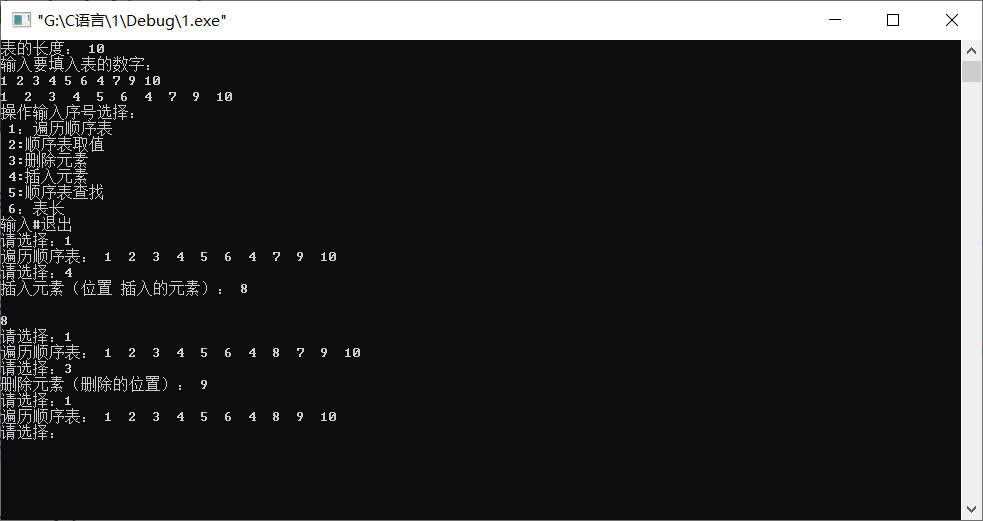线性表基本概念:由同类型数据元素构成有序序列的线性结构
表中元素个数称为线性表的长度
线性表没有元素时称为空表
表起始位置称为表头,结束位置称为表尾
位序i从1开始
1 #include <stdio.h>
2 #include <stdlib.h>
3 #include <string.h>
4 #define MAXSIZE 100//顺序表所能表达的最大长度
5 #define OVERFLOW 1
6
7
8
9 typedef int Status;//重命名,使Status和int有相同的作用
10 typedef int ElemType;
11
12 void Interrupt(void)//创建一个中断函数
13 {
14 while(1) //用于检测换行符,使函数脱离scanf的连续输出
15 if(getchar()=='
')
16 break;
17 }
18
19 typedef struct
20 {
21 ElemType *elem;//存储空间的基地址
22 int length;//当前长度
23 }Sqlist;//顺序表的结构类型为Sqlist
24
25 Status InitList(Sqlist &L)//建立一个空表
26 {
27 L.elem = new ElemType[MAXSIZE];
28 if(!L.length)
29 {
30 exit(OVERFLOW);
31 }
32 L.length = 0;
33 return 0;
34 }
35
36 Status MyList(Sqlist &L)//在空表上输入数字,建立一个属于自己填写的表
37 {
38 int b,i=0;
39 printf("表的长度: ");
40 scanf("%d",&L.length);
41 Interrupt();
42 printf("输入要填入表的数字:
");
43 for( ; i < L.length ; i++ )
44 {
45 scanf("%d",&b);
46 L.elem[i] = b;
47 }
48 Interrupt();
49 return 0;
50 }
51
52 Status TraverseList(Sqlist &L)//遍历 ,使现有表中的数据重新打印出来
53 {
54 int j;
55 if(L.length==0)
56 {
57 printf("空表
");
58 return 0;
59 }
60 else
61 {
62 for(j=0 ; j < L.length ; j++)//建立一个for函数,读取顺序表中的数据
63 printf("%d ",L.elem[j]);
64 printf("
");//最后换行
65 return 0;
66 }
67 }
68
69 Status GetElem(Sqlist &L,int i,int &e)//取值 。i:为要取的值得位置,&e:为i位置的接受变量,并且返回主函数
70 {
71 int c;
72 scanf("%d",&i);
73 Interrupt();
74 if(i<0||i>L.length)//判断i的取值是否超范围
75 {
76 printf("ERROR
");//如果超范围,返回ERROR,并结束
77 return 0;
78 }
79 else
80 {
81 e = L.elem[i-1];//返回将第i位置的数据赋值给e,并输出
82 printf("%d
",e);
83 return 0;
84 }
85
86 }
87
88 Status DeleteElem(Sqlist &L,int i)//删除 。i:为要删除数据的位置
89 {
90 int j;
91 scanf("%d",&i);//输入要删除的第i位
92 Interrupt();
93 if(i<0||i>L.length)//判断输入的i 是否超范围,如果超出,返回错误。
94 {
95 printf("ERROR
");
96 return 0;
97 }
98 else
99 {
100 for(j = i; j<=L.length;j++)//被删除元素之后的元素都向前移一位
101 L.elem[j-1] = L.elem[j];
102 L.length = L.length-1;//表长减1
103 return 0;
104 }
105 }
106
107 Status ListInsert(Sqlist &L,int i,ElemType e)//顺序表的插入 i:为要插入的表的位置。e:要插入该位置的元素
108 {
109 int j;
110 scanf("%d",&i);
111 scanf("%d",&e);
112 Interrupt();
113 if(i>L.length+1||L.length>=MAXSIZE||i<1)//判断要插入表的位置i是否超出范围
114 {
115 printf("ERROR
");
116 return 0;
117 }
118 else
119 {
120 for(j=L.length;j>=i;j--)//插入位置及之后的元素分别向后移一位
121 L.elem[j]=L.elem[j-1];
122 L.elem[i-1]=e;//将新元素e放入第i个位置
123 ++L.length;//表长加1
124 return 0;
125 }
126 }
127
128 Status LocateElem(Sqlist &L,ElemType e)//查找。在顺序表L中查找值为e的数据元素
129 {
130 int j,i=0;
131 bool text=true;//利用bool类型,来判断表里有没有值为e的值
132 scanf("%d",&e);//输入e的值
133 Interrupt();
134 for(j=0;j<L.length;j++)//遍历整个顺序表,和e值一一作比较,
135 {
136 if(L.elem[j]==e)
137 {
138 printf("第 %d 位
",j+1);
139 i++;
140 text=false;
141 }
142 }
143
144 if(text)//bool类型的输出
145 printf("没有找到");
146 return 0;
147 }
148
149 int main()
150 {
151 int a,i=0;
152 char c;
153 Sqlist L;//将L定义为Sqlist类型的变量,便于直接引用
154 InitList(L);
155 MyList(L);
156 TraverseList(L);
157 printf("操作输入序号选择:
1:遍历顺序表
2:顺序表取值
3:删除元素
4:插入元素
5:顺序表查找
6:表长
输入#退出
");
158 while(1)
159 {
160 int f = 0;
161 printf("请选择:");
162 scanf("%c",&c);
163 Interrupt();
164 switch(c)
165 {
166 case '1': printf("遍历顺序表: ");TraverseList(L); break;
167 case '2': printf("顺序表取值(取值位置): ");GetElem(L, a , a ); break;
168 case '3': printf("删除元素(删除的位置): ");DeleteElem(L,a); break;
169 case '4': printf("插入元素(位置 插入的元素): ");ListInsert(L,a,a); break;
170 case '5': printf("顺序表查找(输入要查找的元素): ");LocateElem(L,a); break;
171 case '6': printf("表长: %d
",L.length); break;
172 case '#': f = 1; break;
173 default: printf("ERROR
");
174 }
175 if (f == 1)
176 {
177 printf("已正常退出!
");
178 break;
179 }
180 }
181
182 return 0;
183 }